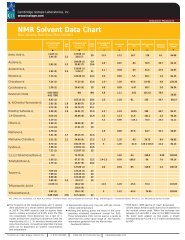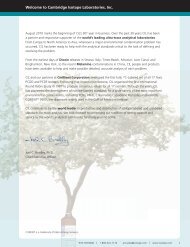Deuterated Solvents for NMR - Cambridge Isotope Laboratories
Deuterated Solvents for NMR - Cambridge Isotope Laboratories
Deuterated Solvents for NMR - Cambridge Isotope Laboratories
You also want an ePaper? Increase the reach of your titles
YUMPU automatically turns print PDFs into web optimized ePapers that Google loves.
<strong>Cambridge</strong> <strong>Isotope</strong> <strong>Laboratories</strong>, Inc. www.isotope.com<br />
<strong>NMR</strong> <strong>Solvents</strong><br />
21<br />
<strong>NMR</strong> SOLVENT DATA ChART<br />
<strong>Cambridge</strong> <strong>Isotope</strong> <strong>Laboratories</strong>, Inc. l www.isotope.com<br />
<strong>NMR</strong> Solvent Storage and<br />
Handling In<strong>for</strong>mation<br />
unit<br />
Please note that some packaging sizes of some solvents may require special handling not given<br />
below. The bottle or ampoule packaging in<strong>for</strong>mation should be reviewed <strong>for</strong> further instructions.<br />
Acetic Acid-d 4 / Acetone-d 6 / Benzene-d 6 / Cyclohexane-d 12 / Deuterium Oxide / N,N-Dimethyl<strong>for</strong>mamide-d 7 / Dimethyl Sulfoxide-d 6 /<br />
1,4-Dioxane-d 8 (p-Dioxane) / Ethanol-d 6 / Methanol-d 4 / Methylene Chloride-d 2 / Pyridine-d 5 / 1,1,2,2 Tetrachloroethane-d 2 /<br />
Toluene-d 8 / Trifluoroacetic Acid-d / 2,2,2-Trifluoroethanol-d 3<br />
Store at room temperature away from light and moisture. The above products are stable if stored under recommended conditions.<br />
Acetonitrile-d 3<br />
Store at room temperature away from light and moisture. This product is stable <strong>for</strong> one year after receipt of order if stored under<br />
above conditions (unopened). After one year, the solvent should be re-analyzed <strong>for</strong> chemical purity be<strong>for</strong>e use.<br />
Chloro<strong>for</strong>m-d / Tetrahydrofuran-d 8<br />
Store refrigerated (-5 o to 5 o C) away from light and moisture. These products are stable <strong>for</strong> six months after receipt of order if stored<br />
under above conditions (unopened). After six months, the solvent should be re-analyzed <strong>for</strong> chemical purity be<strong>for</strong>e use.<br />
Deuterium exchange of Labile Protons in <strong>Deuterated</strong> <strong>Solvents</strong> containing Residual D 2O<br />
Some deuterated solvents are prepared by catalytic exchange of protonated solvent with deuterium oxide and carefully purified by distillation.<br />
Residual water (H 2O in equilibrium exchange with D 2O) is kept to a minimum of 20 - 200 ppm, the higher value corresponds<br />
to the amount in the more hygroscopic solvents. The labile deuterons (and protons) of water are available to exchange with labile<br />
protons in the chemist's sample and can result in inaccurate integration ratios. The example below shows that just 100 ppm of D 2O can<br />
cause problems when studying dilute solutions of analytes. A significant decrease in the integral of 1 labile proton may be observed<br />
in a sample containing 5 mg organic compound, MW~200, dissolved in 1g DMSO-d 6 containing 100 ppm D 2O. The problem becomes<br />
worse as the molecular weight of the analyte increases.<br />
Solution:<br />
Water (as H 2O, HDO or D 2O) can be minimized by adding molecular sieves to the solvent, agitating the mixture and allowing it to stand<br />
<strong>for</strong> a few hours. The water content may be reduced to about 10-20 ppm in this manner. If exchange still causes a problem, it is<br />
recommended to use a less hygroscopic solvent, such as chloro<strong>for</strong>m, methylene chloride or acetonitrile.<br />
X – residual solvent; – residual water<br />
2.01 1.00<br />
*<br />
Figure 1- 1 H <strong>NMR</strong> spectrum of 5.0 mg 2,6-di-tert-butyl-4-methylphenol<br />
(MW 220.36g/mole) in dry DMSO-d 6. Note the proper integral ratios of<br />
18:3:1:2 (t-butyl: methyl: ring-H: -OH). Note the single H 2 O peak at 3.3 ppm.<br />
<strong>Cambridge</strong> <strong>Isotope</strong> <strong>Laboratories</strong>, Inc.<br />
50 Frontage Road, Andover MA 01810<br />
ph: 978.749.8000<br />
ph: 800.322.1174 (N.America)<br />
fax: 978.749.2768<br />
email: cilsales@isotope.com<br />
www.isotope.com<br />
*<br />
*<br />
X<br />
X<br />
3.02<br />
18.00<br />
2.01 0.47<br />
Figure 2- 1 H <strong>NMR</strong> spectrum of 5.3 mg of 2,6-di-tert-butyl-4-methylphenol<br />
in DMSO-d 6 with 100 ppm D 2 O added. Note the reduced ratio of the phenolic<br />
proton 18:3:2:0.47 (t-butyl: methyl: ring-H: -OH). Note that the HOH and HOD<br />
peaks are separated in the spectrum.<br />
tel: 978-749-8000 800-322-1174 (USA) fax: 978-749-2768 cilsales@isotope.com<br />
*<br />
X<br />
2.99<br />
18.00







